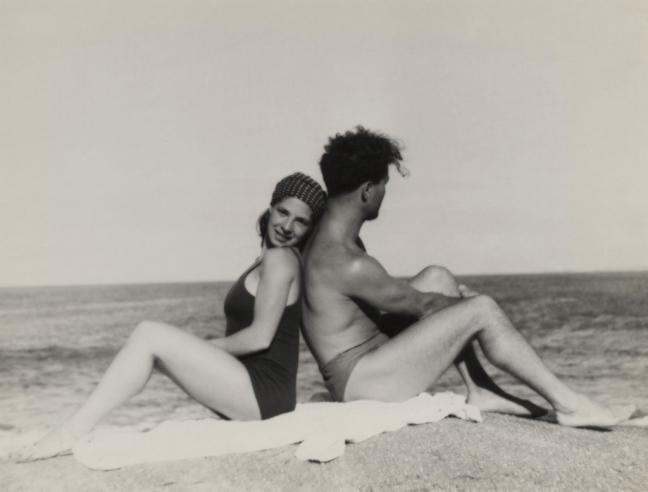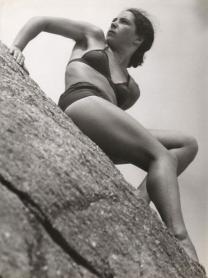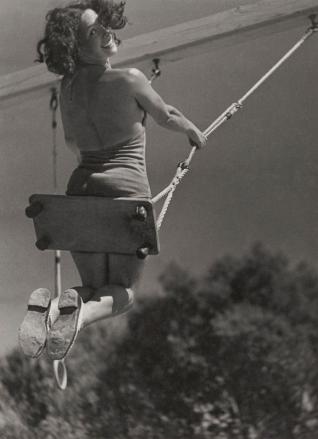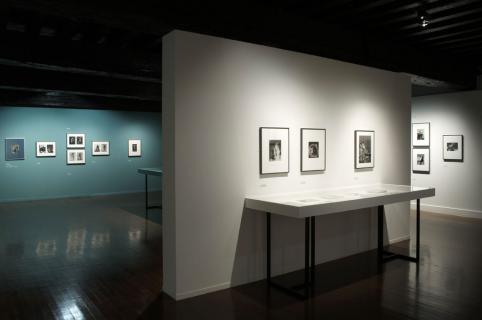This exhibition explores the field of the « Nouvelle Vision » of the 1930s, presenting sixty-six original and personal photographs by André Steiner (1901-1978), for the most part unseen until now. These biographical images show his idyllic intimacy with his wife Léa – known as Lily – and their daughter Nicole. They prove that Steiner took the photography of the intimate family circle as an opportunity and an attempt at intellectual and artistic expression.
André Steiner was a Hungarian Jew who came to Paris with his young wife Lily after eight years in Vienna. He was a qualified engineer and wanted to make it as a photographer in the bubbling city, home of the avant-garde.
His self-portraits show a strange absent stare, internalising everything, making him seem strong and determined. He remained apart from the Hungarian artistic community in Paris on purpose and his photography was a personal and solitary act he considered to be inextricably linked with the technical aspect, scientific research and the idea of an aesthetic adventure. He was a « technician for whom all photos were above all a question of measure and precision».
André Steiner cleaved himself to the rhythm of his time with a faith in science that never left him.
The inter-war years was a time that favoured outdoor living, camping, physical exercise, and clean living. After the carnage of the First World War, art, politics and medicine came together to promote healthy living carried by the vogue for water and snow sports. In Art et Médecine , a modern photography magazine in the November 1934 issue it was deemed that « there is no better aesthetic master than water to work muscles and sculpt flesh ». The cult of the body was everywhere. The magazine VU provided the propaganda for this way of life and often called on André Steiner to illustrate sport and dance revealing their vital energy.
The body, the nude, was the great passion of André Steiner, and not only in photography. As a young man he was an accomplished sportsman. Family documents show that he met Léa at the age of thirteen at the Hakoah, Vienna’s Jewish sports circle. André was one of the trainers of the prestigious swim team Léa belonged to. To see the photos of the young girl in Vienna and those of Lily as a woman in Paris, is to realise the level of metamorphosis a body can reach and what goes on underneath. André Steiner sculpted his own body and contributed to the shaping of his wife’s body. He made them and their anatomies THE subject.
At the start of the fifties, Steiner outlined his conception of the nude and the model. The nude is a piece of fiction « suggested by the operator… The main quality of the model is to lend themselves as a disarticulated puppet, in order to fill up a space that is sometimes cut through by shadows, sometimes exaggerated by too much light… ».
The nudes were perhaps a cold affirmation of what the world should be but the portraits of Lily are unavoidably expressions of the idea we may have of real happiness.
André Steiner used his love for Lily to the extent that from 1928 to the moment of their split in 1938, he was incapable of separating the creation from the real. Like all of the photographers of the « Nouvelle Vision », such as Jean Moral with Juliette or Man Ray with Lee Miller, Steiner turned his partner into the perfect model.
The musée Nicéphore Niépce and the Editions Le Bec en l’Air are publishing a book in tandem with this exhibition:
André Steiner « Ce qu’on n’a pas fini d’aimer »,
Text by François Cheval and Arnaud Cathrine,
144 pages, 100 black and white photographs,
isbn : 978-2-916073-71-2
32 €











